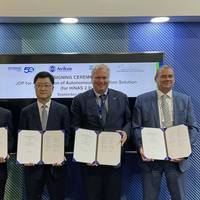DNV, HHI, AVIKUS and LISCR to Develop Autonomous Ship Technology

DNV signed a memorandum of understanding (MOU) with Hyundi Heavy Industries (HHI), AVIKUS and Liberian International Ship & Corporate Registry (LISCR) to collaborate on autonomous ship technology developments.The Hyundai intelligent Navigation Assistant System (HiNAS 2.0) is an AI-based navigation solution that covers all steps for voyage from detection to situation analysis, planning and control. The system assists in safe navigation by displaying AR (augmented reality) images of detected ships and navigation information.
Lloyd's Register Updates East Mediterranean Projects on Alternative Fuels
Three European Commission co-funded initiatives – Poseidon Med II, CYnergy and Elemed – are driving forward the uptake of alternative fuels in the Eastern Mediterranean region.Poseidon Med II: Creating a comprehensive and sustainable supply chain for LNG bunkeringThe Poseidon Med II project is a practical roadmap that aims to promote wide adoption of LNG as a safe, environmentally efficient and viable alternative fuel for shipping and help the East Mediterranean marine transportation propel towards a low carbon future.The project, which is co-funded by the European Union, involves three countries: Greece, Italy and Cyprus, six European ports (Piraeus, Patras, Lemesos, Venice, Heraklion, Igoumenitsa) as well as the Revithoussa LNG terminal.
Maritime Thought Leadership: Koichi Fujiwara, ClassNK

Tokyo-based Nippon Kaiji Kyokai, or ClassNK as it is more commonly known, is one of the world's leading classification societies with 9,104 ships representing 250 million gt under register, as of June 2018. We spoke with Koichi Fujiwara, Chairman, ClassNK, earlier this year in Tokyo for his overview of the market today, and the path forward on technological trends.While Koichi Fujiwara, like many of his colleagues, sees challenging times in the maritime market, he does note that conditions are improving…
KVH Is On 'Watch'

Conceived in its never-ending drive to progressively service its customers, KVH is working on a proprietary Internet of Things (IoT) solution for the commercial maritime market. Code-named “Watch,” KVH’s IoT application is designed to collect, compress, process, transport and analyze system data from ships, with the promise to deliver a broad swath of customizable efficiency solutions. Robert Balog, SVP, Engineering and Michael Mitsock, VP of Marketing discuss the plan with Maritime Reporter & Engineering News.
Definitive Study On The Impact Of Global Sulphur Regulations
Marine Energy Consulting Ltd. (MECL) and 20|20 Marine Energy, two leading consultancies in this field, today announced that they will collaborate to produce a comprehensive evaluation of the impact of MARPOL Annex VI global sulphur regulations on the shipping industry. The study will include a detailed impact assessment of the regulations, as well as insights into compliance solutions, enabling recipients to make more informed decisions when developing strategies to both manage the transition, and the future. The regulations, which mandate the use of bunkers with a sulphur content of less than 0.5% on a global basis, will be implemented in either 2020 or 2025…
Global Marine Technology Trends 2030 report released
Global Marine Technology Trends 2030, released today, is the culmination of a collaborative project between Lloyd’s Register, QinetiQ and the University of Southampton looking at the future for: commercial shipping – without which world trade would cease; for navies – so vital for security; and the health of the oceans – the vital resource that defines the future wellbeing of the planet. In asking ‘what’s next’ GMTT 2030 is an aid to business, policy makers and society in trying to understand the future for the maritime industries and the oceans. Assessing 56 technologies and then focusing on 18 specific areas of technology, GMTT 2030…
DNV GL sees Hybrid Propulsion, Connectivity the Emerging Trends
With 2020 in sight, DNV GL looked at the lessons to be learned from the update to the classification society’s “Shipping 2020” report which was published in 2012. Now, three years later, hybrid propulsion systems and connected ship solutions are emerging technologies that are gaining ground faster than expected, outlined Tor E. Svensen, CEO DNV GL – Maritime, at the opening day of Nor-Shipping in Oslo. “While operational efficiency and emissions reductions are the main motivators behind these developments, the update shows that the future fuel mix will be much more diverse,” Svensen said. LNG as a ship fuel was one of the standouts from the last report…
Schlumberger Announces Q1 Results
Schlumberger Limited (NYSE:SLB) today reported first-quarter 2014 revenue from continuing operations of $11.24 billion versus $11.91 billion in the fourth quarter of 2013, and $10.57 billion in the first quarter of 2013. Income from continuing operations attributable to Schlumberger, excluding charges and credits, was $1.59 billion—a decrease of 11% sequentially but an increase of 23% year-on-year. quarter of 2013. Schlumberger recorded charges of $0.09 per share in the fourth quarter of 2013 and of $0.07 per share in the first quarter of 2013. Schlumberger did not record any charges or credits in the first quarter of 2014. Oilfield Services revenue of $11.24 billion decreased 6% sequentially, but increased 6% year-on-year.
World Fleet Set to Change: DNV's Shipping 2020 Scenario

DNV’s Shipping 2020 scenario explores technology uptake based on market forces, regulatory changes, fuel prices, technology costs & specific shipowner requirements. Based on expected market developments, regulatory changes, fuel prices, cost and availability of new technology and specific shipowner requirements, the model explores the technologies with the best payoff that will also ensure compliance with the relevant environmental requirements. Economic power is shifting to Asia, impacting trade routes and the demand for vessels.
DNV Predicts Ship Propulsion Technology Uptake to 2020

The results show that high fuel costs will result in a drive towards more energy efficient ships ahead of the EEDI regulatory timeframe. Fuel choices up to 2020 will be driven by the time spent in an Emissions Control Area (ECA), but distillate is a more likely option than scrubbers for most ships towards 2020. By 2020, it is expected that new tankers, bulkers and container vessels will be up to 30 per cent more energy efficient than today’s newbuildings. DNV predicts that one-third of the reductions will be cost effective for shipowners.
The Automated Ship: An Easier Path to Upgrading
A pragmatic European research initiative aimed at enabling ships already in service to more easily and more rapidly benefit from advances in computer and control technology has led to a demonstrator system being installed on the bridge of a Swedish icebreaker. The development of a methodology for retrofit applications to the existing European fleet, so as to increase the pace of technology uptake beyond that governed by newbuilding construction, is the main goal of the pan-industry study known as Atomos IV(advanced technology to optimize maritime operational safety). Besides improved safety, anticipated benefits include the introduction of more human-centered and usable systems, better information access, and faster and more reliable operations.





